
Welcome to charlottesnakes.com! I am David, a snake enthusiast living in Charlotte, NC. Many people don't know that Charlotte is in fact full of snakes! You just need to know where to find them - they can often be shy and elusive. Some North Carolina snake species are more common outside of the city limits, in different parts of Mecklenburg County NC, but many types of snakes are indeed common in the more urban parts of Charlotte. This guide is meant to help educate you about the beautiful snakes of Charlotte, and to help you identify the most common snakes of Charlotte, as well as the venomous snakes of Charlotte that you should learn to recognize and avoid. If you want more detail, click here for my complete list of ALL snake species in Charlotte. Remember the following:
- Most snakes of Charlotte are harmless and don't want to encounter you
- Venomous snakes exist but are uncommon in Charlotte, North Carolina
- Snakes eat rats and mice and are a valuable part of the North Carolina ecosystem
- Never kill a snake - if you leave a snake alone, it will leave you alone.
Common Snake Species in Charlotte
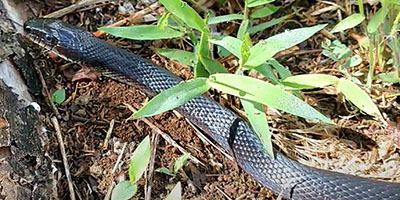 Black rat snake:
They are the most commonly encountered snakes around human dwellings. They are typically attracted to homes and other properties by their prey, rats, and other small rodents and animals. Black rat snakes are black in color. Their bellies have a combination of white and black scales. These non-venomous snakes are expert climbers and apply their climbing skills in seeking habitats around human dwellings and hunting prey.
Black rat snake:
They are the most commonly encountered snakes around human dwellings. They are typically attracted to homes and other properties by their prey, rats, and other small rodents and animals. Black rat snakes are black in color. Their bellies have a combination of white and black scales. These non-venomous snakes are expert climbers and apply their climbing skills in seeking habitats around human dwellings and hunting prey.
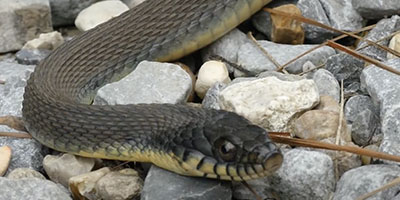 Northern water snake:
These non-venomous snakes are commonly mistaken for copperheads because of their physical features. Their bodies have different colors, including gray, brown, and tan. The snakes are closely associated with water snakes and are commonly encountered on or around freshwater bodies.
Northern water snakes can be aggressive, especially when they are provoked. Although they do not produce venoms, they can bite intruders and predators.
Northern water snake:
These non-venomous snakes are commonly mistaken for copperheads because of their physical features. Their bodies have different colors, including gray, brown, and tan. The snakes are closely associated with water snakes and are commonly encountered on or around freshwater bodies.
Northern water snakes can be aggressive, especially when they are provoked. Although they do not produce venoms, they can bite intruders and predators.
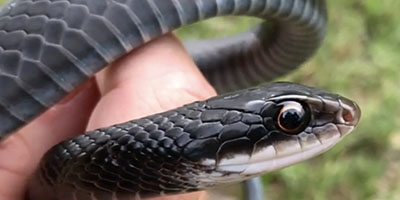 Black racer snake:
These non-venomous snakes are commonly encountered in North Carolina. They could be aggressive when provoked and are known for their speed. They are medium-sized snakes commonly encountered in open spaces.
It is best to leave black racers alone when encountered. The snakes are most commonly encountered when they are basking in the sun in open spaces.
Black racer snake:
These non-venomous snakes are commonly encountered in North Carolina. They could be aggressive when provoked and are known for their speed. They are medium-sized snakes commonly encountered in open spaces.
It is best to leave black racers alone when encountered. The snakes are most commonly encountered when they are basking in the sun in open spaces.
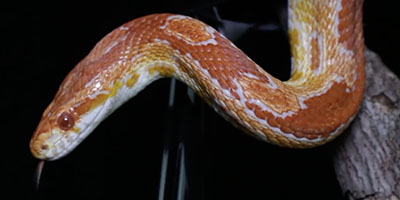 Corn snake:
These non-venomous snakes are commonly encountered in the edges of fields in Charlotte, North Carolina. They feed on small animals and rodents such as rats. Corn snakes have distinct physical features such as the square red or red-orange blotches that are found on their gray, orange, or brown skin.
Corn snake:
These non-venomous snakes are commonly encountered in the edges of fields in Charlotte, North Carolina. They feed on small animals and rodents such as rats. Corn snakes have distinct physical features such as the square red or red-orange blotches that are found on their gray, orange, or brown skin. 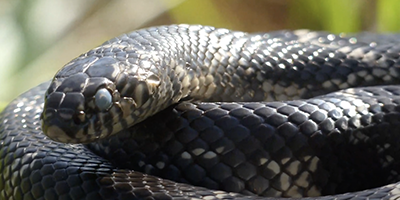 Eastern kingsnake:
The eastern kingsnake is found in a wide range of habitats, including aquatic habitats. They are known for distinct physical features such as their chain-like patterns. The chain-like patterns are either white or yellow and are found on their black bodies.
Although they are non-venomous snakes, the eastern kingsnake is known for its ability to eat other snakes, including venomous snakes like copperheads.
Eastern kingsnake:
The eastern kingsnake is found in a wide range of habitats, including aquatic habitats. They are known for distinct physical features such as their chain-like patterns. The chain-like patterns are either white or yellow and are found on their black bodies.
Although they are non-venomous snakes, the eastern kingsnake is known for its ability to eat other snakes, including venomous snakes like copperheads.
Venomous Snake Species in Charlotte
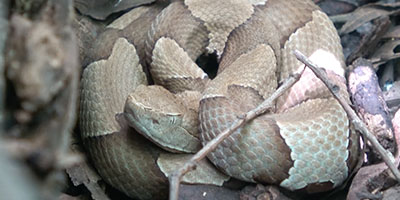 Copperhead:
Copperheads are amongst the commonest venomous snakes found in Charlotte, North Carolina. They can be easily identified by their characteristic copper-colored heads. The brown color of their bodies as well as the hourglass patterns on their backs are other distinguishing features. These venomous snakes are so common in North Carolina that a major proportion of venomous bites are attributed to them.
These venomous snakes can grow up to three feet in length. The bites of copperheads can result in serious consequences and they are widely distributed across the state.
Copperhead:
Copperheads are amongst the commonest venomous snakes found in Charlotte, North Carolina. They can be easily identified by their characteristic copper-colored heads. The brown color of their bodies as well as the hourglass patterns on their backs are other distinguishing features. These venomous snakes are so common in North Carolina that a major proportion of venomous bites are attributed to them.
These venomous snakes can grow up to three feet in length. The bites of copperheads can result in serious consequences and they are widely distributed across the state.
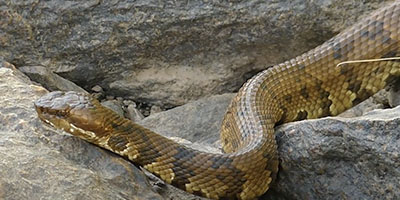 Cottonmouth:
The cottonmouth, otherwise known as the water moccasin, is commonly found in aquatic environments. They have distinctive features such as the white lining of their mouth. They also have dark bands on their bodies. The body of cottonmouths can be olive-colored or dark.
In Charlotte, North Carolina, cottonmouths are mostly found in freshwater environments. They can grow as long as six feet in length. The average length of the snakes is between three and four feet. A notable behavioral attribute of these snakes is that they stand their ground when they are threatened or feel unsafe.
Cottonmouth:
The cottonmouth, otherwise known as the water moccasin, is commonly found in aquatic environments. They have distinctive features such as the white lining of their mouth. They also have dark bands on their bodies. The body of cottonmouths can be olive-colored or dark.
In Charlotte, North Carolina, cottonmouths are mostly found in freshwater environments. They can grow as long as six feet in length. The average length of the snakes is between three and four feet. A notable behavioral attribute of these snakes is that they stand their ground when they are threatened or feel unsafe.
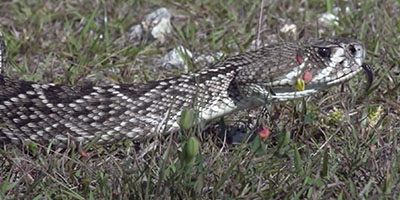 Eastern diamondback rattlesnake:
The eastern diamondback rattlesnake is the heaviest venomous snake found in the US. They have distinctive physical features such as the dark diamond pattern on their backs. These snakes can grow up to eight feet. The average length of an eastern diamondback rattlesnake is between four feet and five feet.
They have grayish or yellowish skin and can be identified by the combination of their skin and the diamond pattern. They also produce a distinctive rattling sound when encountered. Bites from these snakes are very severe and should be treated as medical emergencies.
In North Carolina, the snakes are found in different areas, specifically the coastal and sandy regions.
Eastern diamondback rattlesnake:
The eastern diamondback rattlesnake is the heaviest venomous snake found in the US. They have distinctive physical features such as the dark diamond pattern on their backs. These snakes can grow up to eight feet. The average length of an eastern diamondback rattlesnake is between four feet and five feet.
They have grayish or yellowish skin and can be identified by the combination of their skin and the diamond pattern. They also produce a distinctive rattling sound when encountered. Bites from these snakes are very severe and should be treated as medical emergencies.
In North Carolina, the snakes are found in different areas, specifically the coastal and sandy regions.
If you're unsure, you can email me a photo of the snake at info@charlottesnakes.com and I will email you back with the snake's species. If you found a snake skin, read my Found a Skin? page, and you can email me a photo of the skin, and I'll identify the snake for you. If you need professional Charlotte snake removal help, click my Get Help page, or see the below website sponsor I found, who provides that service.
Guide on the Water Moccasin Snake
Water Moccasin is also called Cottonmouth, derived from the white pigmentation found inside the snake's mouth. It has various local names like water pilot, water mamba, trap-jaw, swamp lion, etc. They belong in the group of pit vipers, which is known for the heat-sensing pit found in the middle of their nostrils and eyes.
What is the Appearance of the Water Moccasin?
They are relatively large snakes that can measure at about 61-122 centimeters in length. Their jowls are prominent, which is probably due to the location of their venom gland. Their pupils resemble the eyes of the cats. They have a pale snout and have a noticeable dark coloring on their nostrils, which can be important when identifying them. Their physical appearance can be similar to some of the harmless and non-venomous snakes. They have a triangular head that is different from their thin necks. Compared to other snakes, they will not have any distinctive features on their neck. They have a stout and muscular body. The color may vary from the yellow, banded brown, olive, black, and dark brown. Their bellies will typically be paler compared to their back.
Where is the Habitat of Water Moccasin?
Most Water Moccasin will inhabit the southeastern part of the US. You may find them from Virginia's swamps to the ponds of Florida up to the eastern section of Texas. You might encounter them swimming on marshes, streams, lakes, drainage ditches, and at the edge of the ponds. When on land, they will often stay in the fields and near the water sources where most of their prey can be found. They will bask on logs, stones, and branches close to the water. It helps them keep their temperature in check.
What is the Typical Diet of Water Moccasin?
Water Moccasin will be active on both day and night. However, they will hunt for their food at night, especially during the summer season. They can eat other snakes; even the smaller water moccasin is included in their diet. They can also feed on turtles, small or baby alligators, lizards, birds, amphibians, and small mammals. They are known for being aggressive but will not necessarily bite a human. However, rather than fleeing from the sign of danger, they will stand their ground. The venom of the water moccasin prevents the blood of the victim from clotting.
What is the Mating Behavior of the Water Moccasin?
The mating season of this snake will start in the spring season. The males will slither and wave their tails to draw the attention of the female snake. There will also be a competition among male snakes. They are ovoviviparous, which means that the eggs will incubate in the mother's body, and the mother will deliver a live young. One litter can be composed of 10-20 baby snakes. They will be born with bright colors and will immediately leave the nest after they are born.
Remember, the term is not poisonous snakes of Charlotte, it's venomous snakes of Charlotte. Poison is generally something you eat, and venom is injected into you. That said, dangerous snakes are very rare in Charlotte. The few venomous snakes of Mecklenburg County are rarely seen. But they are commonly misidentified, so learn about all the snake species of Charlotte in order to correctly identify them. These snakes are usually also found in the surrounding towns of Charlotte, Huntersville, Matthews, Cornelius, Mint Hill, Pineville and the surrounding areas.
Read our article about:
What Does Snake Poop Look Like?
charlottesnakes.com domain and hosting costs made possible by the generous support of this sponsor:
